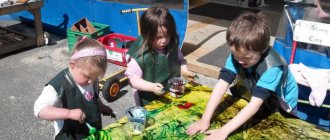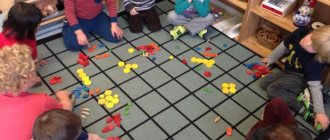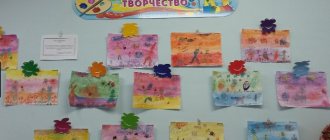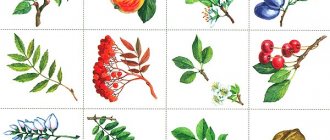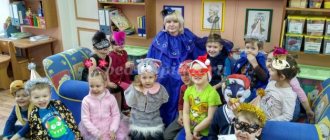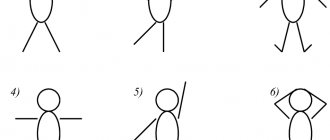Svetlana Agafonova
Summary of a lesson on the surrounding world in a preparatory group on the topic “Wild berries”
Familiarization with the outside world in the preparatory group on the topic
«
Berries
«
Tasks :
Generalization and systematization of ideas about the changes occurring in the life of the forest in autumn, about wild berries
, places of their growth;
Activation and updating of the dictionary on the topic
“
Berries ”
. Forest in autumn” (forest, swamp, berry
, cranberry, lingonberry, blueberry, cloudberry, blackberry, raspberry)
Fostering a caring attitude towards nature.
On the topic: methodological developments, presentations and notes
Abstract of OOD on artistic design in the middle group.
Goal: expanding and enriching children’s knowledge about “mushrooms”, “berries”, their habitat, purpose, time of collection; generalization of children's knowledge about mushrooms and berries of our forests. Final m.
Calendar-thematic planning in the middle group on the topic “Wild berries and mushrooms.”
Using this material, it is easy and simple to introduce children to wild mushrooms and berries.
Introduce children to wild berries; teach children to distinguish between garden and forest berries; to educate children to respect nature. Materials and equipment: posters with images of berries; ill.
Source
Preparation
Drawing classes allow the child to develop comprehensively
The result of achieving the goals and objectives depends on how thoroughly the teacher prepares for the lesson - this is no secret. And taking into account all the subtleties of the preparatory process plays an important role in this process.
Materials
In the preparatory group, children are already familiar with the main types of drawing materials. That is, they can use
- pencils;
- gouache;
- watercolor;
- wax crayons;
- markers.
This is interesting. Many methodologists categorically deny the possibility of using felt-tip pens in drawing classes in kindergarten, since children cannot use them to convey shades and elementary shadows in an image.
The basis
The A4 format is most convenient for children to use.
As a basis for drawing you can use:
- paper of different thicknesses (colored or printer paper);
- cardboard (thick and thin).
The only condition is that the drawing format should not be larger than A4 if we are talking about individual work. For group assignments, you can use sheets of A3 and even A1 format.
This is interesting. Images on whatman paper are allowed if the teacher takes an active part in creating the overall composition of the work.
Techniques and techniques in the preparatory group
As a task for sketching, children can not complete the entire composition, but only its element
It is assumed that in the preparatory group children already know a number of non-traditional drawing techniques (for example, blotography, when an outline is applied to random spots of paint, or palm painting, when various images are created based on the outline of the palms). However, classical techniques still remain a priority. Among them
- coloring picture templates;
- completing the composition on a ready-made background (for example, a forest background is complemented by a drawing of a hedgehog, squirrel, mushrooms, berries, etc.);
- sketching (this technique is actively mastered in the senior group and practiced in the preparatory group);
- tracing and coloring stencils (in the group the figures depicted are becoming more complex, animals appear with traced contours of fur, small objects in the composition, etc.);
- drawing from life (natural materials are used as nature - branches, stumps, acorns, chestnuts, etc.).
To depict mushrooms and berries, it will be important to use additional drawing, sketching and drawing from life.
Drawing techniques are determined by the fact that children already have clear ideas about the point-boundaries of the image, determined by the idea of the drawing. Available for children 6–7 years old
- any form of painting (small, large details, as well as elementary shadows);
- drawing thin and wide lines in any direction;
- vertical position of the brush when drawing thin lines and inclined position of the brush for wide lines (when using paints);
- dipping, when a brush dipped in paint is applied to the paper with all its bristles to make a print;
- mixing a watercolor palette to obtain different shades;
- techniques for painting in different positions of the pencil in relation to the sheet.
In a lesson on mushrooms and berries, you can combine all these techniques, depending on what materials will be used.
Photo gallery of drawings made using non-traditional techniques
Using semolina painted in different colors using watercolor or gouache allows you to quickly fill the image with color
Drawing with cotton swabs is a type of blotography where an object takes its shape from a spot of paint.
To create this drawing, the technique of fingerprinting paint was used.
How to personalize work?
The implementation of an individual approach is one of the main goals of the educational process in kindergarten. This is easier to do in drawing classes than in others, since the final product is a priori unique. And yet, the teacher can already achieve the goal at the stage of setting the task. To do this, an adult can give the following drawing options:
- present the composition at different times of the day (day, night, morning) or different times of the year, which implies the use of different colors;
- depict a picture from life in different approximations (for example, from close range if the baby has vision problems);
- add one element to a given composition at your discretion and prove the validity of this detail.
This is interesting. To individualize the drawing, you can invite children to add elements of other types of visual activities, for example, appliqué made from natural materials, fabric, or three-dimensional plasticine parts.
Composition options
Drawing, as already mentioned, can be done individually and collectively. In the latter case, it is better if these are elements (for example, pine, squirrel, mushrooms, etc.) made on separate sheets and then placed against a general background . Alternatively, children can color individual blocks of the overall composition. As for the thematic variety of using images of mushrooms and berries as a task, this is traditionally an “autumn-winter” thematic block, when kids study natural phenomena, the life of animals associated with the changes of the seasons. You can suggest the following ideas for wording the topic:
- “Supplies for a hedgehog”;
- "Rowan Branch";
- "Mushroom Glade";
- "Amanita";
- “Bullfinches on a rowan branch”;
- “Who hid there under the tree?”;
- “Gifts for a squirrel”, etc.
Summary of the drawing lesson “Berries” in the preparatory speech therapy group
Elena Vorobyova
Summary of the drawing lesson “Berries” in the preparatory speech therapy group
Prepared and conducted by : teacher Elena Borisovna
- strengthen the ability to use a brush;
— paint with the end of the brush;
- develop productive thinking, perception of color, shape, size; fine motor skills;
- cultivate interest in creative visual activities;
- show a friendly attitude towards fairy-tale characters and a desire to help them.
• Continue teaching children to draw berries , conveying their distinctive features.
• Expand children's knowledge and understanding of forest and garden berries .
• Create conditions for the development of cognitive skills in children, promote the creative activity of children.
— teach to be careful with unknown berries ;
- cultivate a caring attitude towards nature.
Albums for each child, gouache, brushes, large and small. Sippy cup, napkins, cloths for blotting brushes, color illustrations of berries ,
Preview:
Municipal Autonomous Educational Institution
“Gymnasium and M. N.V.
108840, Moscow, Troitsk, st. Shkolnyaya, 10, tel/fax 8(4958)-51-03-11,
"Wild berries and strawberries"
Prepared and conducted:
Ivanova Anna Viktorovna
- strengthen the ability to use a brush;
- draw with the end of the brush;
- develop productive thinking, perception of color, shape, size; fine motor skills;
- cultivate interest in creative visual activities;
- show a friendly attitude towards fairy-tale characters and a desire to help them.
— expand children’s understanding of wild berries;
- continue to introduce the features of appearance and place of their growth;
— teach to be careful with unknown berries;
- cultivate a caring attitude towards nature.
Sheets of white thick paper, watercolor paints, a round brush, a container of water, color illustrations of berries and strawberries.
Psychological game “Wishes”
Children stand in a circle.
Educator. Guys, let's imagine that the ball we hold in our hands is a little sun and we will pass it from hand to hand to a friend standing next to you with wishes (health, happiness, good friends, fun, etc.).
At the end of the game, we move on to the main part of the lesson.
Red juicy droplets of summer,
These berries are tastier than candy,
They grow together on a hillock in the forest,
I'll bring them home in a basket!
Educator. Dunno came to us today, yesterday his friend Znayka told him that strawberries are called drops of summer, but Dunno doesn’t know why they are called that, let’s help him. (Strawberries ripen in the summer and turn red in the clearing, hanging like a drop from the end of a thin stem. These berries are very aromatic and fragrant.)
Looking at an illustration depicting berries.
— What are they in color and shape? (Strawberries are small, small, round, oval, they are red in color, with white small seeds.)
— What kind of leaves does the strawberry bush have? (Green, carved.)
—What do strawberries taste like? (Sweet, juicy, tastier than candy.)
—Where do strawberries grow? (On the edges of the forest, in sunlit forest clearings.)
- Why is this berry called strawberry? (This berry grows near the ground, as if clinging to it.)
Educator. Children, Dunno invites us to color the strawberries so that we can see them among the green grass. What color watercolor paint will you choose?
Finger gymnastics “Picking berries”
One two three four five
We're going for a walk in the forest,
We'll find strawberries
We'll bring it to my brother too.
(Children “greet” each other with the fingers of both hands. Now they “walk.” Bend one finger at a time.
The teacher hangs the children's drawings on the board or lays them out on the carpet. “We found ourselves in a strawberry meadow. Would you like to pick these berries and put them in a basket?”
Summary of the drawing lesson “Rowan Twig” in the senior group
Leonila Shidlovskaya
Summary of the drawing lesson “Rowan Twig” in the senior group
Drawing
"
Rowan Twig " (
senior group ) .
rowan branch on a piece of paper using different drawing : dipping, poking, drawing with the tip of a brush , drawing with a finger . 2. Develop the ability to mix paints on a sheet of paper or on a palette.
3. To develop the ability to notice and reflect the beauty of nature in drawings, to instill love and care for it.
Preliminary work: toning a sheet of paper; conversations about the tree - rowan .
Stages of working on a drawing
"Basket with mushrooms for a hedgehog"
This drawing can be done using the sketching technique
To complete this drawing, you can use both watercolor and gouache. First, children make a pencil sketch of mushrooms, and then complete the drawing (without a pencil outline) of the basket.
Instructions:
- “We draw with a pencil the ovals of the caps and legs of the mushrooms.”
- “We paint them in yellow-beige-brown colors.”
- “We use beige paint to make an oval into which we write mushrooms.”
- “We finish drawing the basket, color it yellow.”
- “We let the background dry for 1-2 minutes and apply a pattern of cells with brown paint.”
- “We also use brown to imitate weaving on the handle of the basket.”
This is interesting. If there is no beige paint in the palette, then you can make it by mixing white with yellow, adding a little brown.
"Bunch of Rowan"
The size of the image of rowan berries trains the baby's eye and sense of proportion
To complete this drawing, the dabbing technique is recommended, but a pencil outline is not required at all.
Instructions:
- “Dip the brush into brown paint and paint a twig.”
- “We apply thin short strokes like branches with green color.”
- “We draw berries on each branch, making dots with orange or red paint.”
- “Dip the brush into the green paint again and paint the branches for the leaves, making them thin but long.”
- “Now we apply the leaves by applying the bristles of the brush in one direction to the long green branches.”
"Amanita"
Drawings with felt-tip pens are usually practiced in classes devoted to creating an illustration for a fairy tale heard or a cartoon seen.
This drawing can be an illustration for a poem or fairy tale you have listened to, and since it is done with felt-tip pens, it takes a little less time to create. That is why such pictures can be supplemented with accompanying elements (in this case, butterflies, clouds, etc.).
Instructions:
- “We start by drawing the contours of the tree.”
- “We show the branches and draw marks on the birch trunk.”
- “Drawing the caps and legs of fly agaric mushrooms.”
- “We color them, not forgetting to leave white spots.” You can use not only felt-tip pens for coloring, but also pencils.
- “We draw butterflies. We draw an oval outline for the body, add wings in the form of the number 3, add a circle-head, and don’t forget about the antennae.”
- "Coloring butterflies."
- “We close the wavy lines into a shape similar to a circle - these are clouds.”
- “Coloring the clouds, finishing the sun.”
Photo gallery of finished works
The theme of mushrooms and berries allows you to practice still life painting skills
kids love to personify their illustrations with fairy tale characters. By depicting mushrooms, children learn to reproduce different shapes
Video: How to draw a bunch of rowan, educational video for children
Video: Learning to draw mushrooms of different shapes
Drawings of mushrooms and berries in the preparatory group can be either an illustration of the studied material related to the theme of autumn, preparations for animals, or gifts of the forest, or a way to practice artistic techniques using paints and pencils. In addition, these drawings allow you to practice the skill of creating images without a pencil outline, which, in turn, teaches children not only to maintain proportions and work without rough lines, but also trains their eye, and also develops a sense of color.
Abstract of an open educational activity on artistic and aesthetic development of drawing “Berries for Mishutka”
Yulia Sorokina
Abstract of an open educational activity on artistic and aesthetic development of drawing “Berries for Mishutka”
«Berries for Mishutka»
Objectives: Teach the poking technique, creating an image by using a point as a means of expression.
Goal: To consolidate the ability to use a brush, to draw with the end of the brush .
Develop productive thinking, perception of color, shape, size; fine motor skills, reaction speed, intelligence, mental, speech, physical activity. Cultivate interest in creative visual activities; friendly attitude towards fairy-tale characters, desire to help them.
